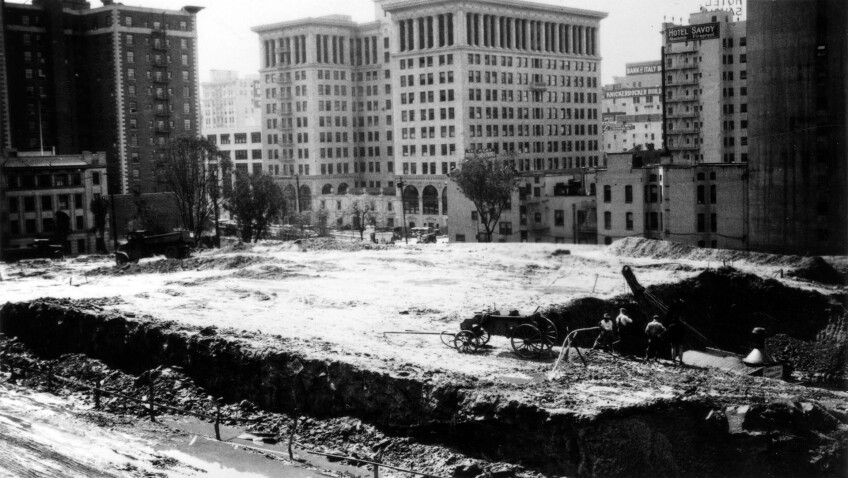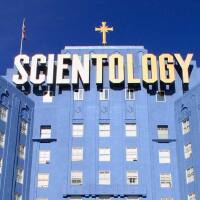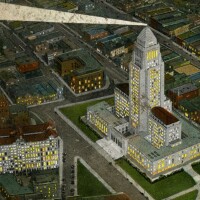Los Angeles in Buildings: The Central Library

Stand outside any entrance of Los Angeles' Central Library, look up, and you see only tall buildings, all of them clearly dating from the mid-20th century and later. 611 Place, Aon Center, the twin towers of City National Plaza, and the Citigroup Center all bear the marks of the late 1960s and ‘70s; in the 1980s and ‘90s appeared the Gas Company Tower and, tallest of all, the U.S. Bank Tower, commonly known as the Library Tower. That last gets its nickname not from the presence of public library facilities on any of its 73 floors, but from the source of the air rights – literally, the legal right to build upward into the air – that allowed it rise to 73 floors in the first place. That skyscraper owes its existence to the library, but the library also owes its existence to that skyscraper.
The Los Angeles Public Library had finally arrived in its own permanent home: not just a building in which to store books, but a temple to knowledge itself.
In this context of utilitarian verticality, an aesthetic common to downtowns across America since the time of postwar “urban renewal,” the Central Library can look like a relic from an era of altogether different values. But when it first opened in 1926, it looked like an arrival from a future of altogether different values, having taken shape, after several revisions, in a style almost avant-garde in its use of hard geometric edges, raw concrete surfaces, abundant allusions to distant places and times – Egypt, Rome, Byzantium, the Islamic world – and a philosophical foundation in addition to its concrete one. The Los Angeles Public Library, having had to move from rented space to rented space since its founding in 1872, had finally arrived in its own permanent home: not just a building in which to store books, but a temple to knowledge itself.

The design, both inside and out, makes that purpose explicit. At the top of one staircase a goddess statue has always stood, flanked by a pair of sphinxes and holding open a book whose pages offer a multilingual selection of quotations: the Bible's “In the beginning was the word,” Seneca's “Knowledge extends horizons,” Keats' “Beauty is truth, truth beauty.” Her body bears images of mankind's progress from East to West: the Egyptian pyramids, the tablet of the Ten Commandments, the Parthenon, Notre Dame, the Liberty Bell, a procession of covered wagons. Her name is “Civilization,” and her creator is Lee Lawrie, a sculptor best known for the forcefully symbolic works made for some of the grander American buildings of the early 20th century, especially the bronze Atlas seen in front of Manhattan’s Rockefeller Center (and on certain editions of Ayn Rand's “Atlas Shrugged”).
Lawrie came as something of a package deal with Bertram Goodhue, the New York architect hired to design the Central Library. They'd previously worked together on projects like St. Bartholomew's Episcopal Church in New York, chapels at West Point and the University of Chicago, and the Central Library's clearest aesthetic precedent, the Nebraska State Capitol. The blunt, symmetrical podium-and-tower exterior of that monumental structure, designed in 1920, stood in stark contrast to the elaborate Spanish Colonial Revival master plan and building designs Goodhue had come up with earlier, in 1915, for the Panama California Exposition in San Diego, the work that made his name in California and which did much to eventually win him the Central Library commission.

Despite having then personally moved on from Spanish Colonial Revival, Goodhue initially managed to come up with a design for the Central Library sufficiently infused with that official style of the “Ramona” vision of Southern California. This addressed some of the objections aired by officials (including Mayor George Cryer) to hiring a non-local architect – much less a high-bidding East Coaster – that prolonged the selection process for months. Yet even after Goodhue got the job, his design had a number of rejections still to endure, and with each revision demanded it moved farther away from Spanish Colonial Revival and closer to a strikingly different, almost sui generis modernism.
Some of the Central Library's unusual qualities arise from its unusual site. Los Angeles' first major boom, which saw its population grow from around 100,000 at the turn of the 20th century to 1.2 million at the end of the 1920s, coincided with the peak influence of the City Beautiful movement across the English-speaking world. That fashion in city planning, conceiving of urban aesthetics as a tool of moral improvement, emphasized the importance of elegantly landscaped parks and neoclassical monuments. When it became embarrassing that Los Angeles lacked a dedicated public library facility commensurate with the city's newfound importance, to say the nothing of the far greater importance boosters envisioned ahead, some City Beautifiers argued for putting the monumental public building and the green space (or at least what green space would remain thereafter) together by building it in Pershing Square.
The downtown park fell out of the running as a site, however, when the city came into possession of the old location of the State Normal School, UCLA's predecessor, unoccupied since the institution moved to its Vermont Avenue campus in 1914. Though much easier to develop, the cramped parcel (first proposed as a library site in a 1907 report by City Beautiful planner Charles Mulford Robinson) at the end of a cul-de-sac between Bunker Hill and the Bible Institute posed serious design challenges. These were somewhat alleviated in 1923 when the library board bought up the properties along adjacent Flower Street, thus allowing the plans to expand a bit farther out to the west, but that only heightened confusion about which side of the building should get its main entrance. Goodhue's unorthodox solution: simply make the four sides' entrances stylistically different, each its own separate aesthetic experience.


Not that the Central Library, when it first opened, offered nothing to catch the eye but four distinct entrances. Lawrie conceived of its extensive sculptural program as “a branch grafted on to the architectural trunk,” producing “forms that portray animated life, emerge from blocks of stone and terminate in historical expression.” This accorded with “The Light of Learning,” the thematic scheme drawn up by Hartley Burr Alexander, the University of Nebraska philosophy professor with whom Goodhue and Lawrie had previously worked on the Nebraska State Capitol. “Light and learning are associated together by an impulse so natural that it pervades the great literature of the world,” says Alexander's explanatory text in the 1927 guide to the library. “Knowledge is imagined as a lamp, wisdom as a guiding star, and the conscious tradition of mankind as a torch passed from generation to generation.”
More than a few visitors have seen, and continue to see, a sinister element in the building's sculptures, decorations, and inscriptions.
Noble though that may sound, more than a few visitors have seen, and continue to see, a sinister element in the building's sculptures, decorations, and inscriptions. The Central Library's mosaics, sphinxes, and especially the pyramid that tops its tower betray to them the deep influence of such much-mythologized “secret societies” as the Freemasons or even the Illuminati. Despite the Masonic resonances of certain design elements, writes Los Angeles Public Library docent Kenon Breazeale, “there is no overt use of the Masons’ easily recognizable 'trademark' of the compass and square” anywhere in the building Goodhue designed. To “conspiracy buffs,” he and Lawrie's previous work on the University of Chicago's Rockefeller-sponsored chapel “is deemed an adequate demonstration of both men’s willingness to take orders from an occult elite bent on world domination.”
You could read these features as signs of a buried will to power, but you could also read them as signs of insecurity. In that interpretation, Los Angeles, having lacked the kind of grand downtown public-library building seen in so many of the longer-established “great cities” of the world, attempted to make up its perceived intellectual credibility deficit – a campaign that still hasn't quite ended – with a heartily overt, almost worshipful display of appreciation for learning. Hence, for instance, the sometimes-translated Latin quotations chiseled into the exterior walls; hence the likenesses of Herodotus, Socrates, and Leonardo da Vinci now staring out at their own reflections in the glass of all those skyscrapers.
All this might seem incongruous with the concept of a library laid out like a department store (and indeed formerly housed in one, having occupied part of Hamburger's Department Store on Broadway and 8th between 1908 and 1914). City Librarian Everett Perry, who pushed for the construction of the Central Library since his 1911 arrival in Los Angeles, had a floor plan in mind which granted each department its own reading room connected, through the stacks, to a central space of card catalogs and circulation desks. (The underlying notion of a large library made of interconnected smaller libraries would come to resonate, decades later, with the widely held perception of midcentury Los Angeles itself as a “multi-centered” metropolis.)


Though the spatial preferences of librarians and architects, the former tending toward the functional and the latter toward the artistic, haven't always proven compatible, Goodhue could work with Perry's non-negotiable layout, placing that central space under an ornate rotunda. Into that space arrived, in 1933, a series of murals by artist Dean Cornwell (promoted, with Los Angeles' usual marketing panache, as the largest work by a single artist since Michelangelo and the Sistine Chapel) depicting the history of California. But Goodhue never lived to see those them, nor did even to see the completion of the Central Library itself, which opened in 1926, two years after Goodhue's sudden death of a heart attack.
The remaining work fell to his longtime associate Carelton Winslow, and though Winslow completed it by all accounts ably, the ensuing decades saw the building become increasingly inadequate to its role. Its publicly accessible stacks held an ever-smaller proportion of the books in the library's collection, forcing patrons to ask clerks to retrieve most of the books they wanted from the internal stacks, and eventually all the usable storage space in the entire aging structure filled to the bursting point, a situation helped not at all by ever-more-deferred maintenance.
“The Central Library is an antiquated firetrap,” argued historian and novelist John D. Weaver in a 1975 issue of the Los Angeles Times Book Review. “No self-respecting landlord would permit it to be used as a sweatshop and no collector of rare books and manuscripts would suffer it to shelter his treasures for a single hour.” As Goodhue's building “huddles in the shadow of the new downtown skyscrapers like the decrepit townhouse of an elderly widow clinging to the home she came to as a bride 50 years ago,” and as “library use is declining at the Central Library and the branches closest to it, promoters of a new building insist it be located in downtown Los Angeles, where the money is, rather than in the Valley, where the heaviest library usage is, or in the black or brown communities” with the greatest need.
Weaver saw Los Angeles as “a city that long ago lost its center,” and the campaign to keep the Central Library central as a spasm of “the same downtown boosterism that flung up a magnificent terminal for trains at the dawn of the air age.” Others shared his critical view, thinking that a decentralized city needed an equally decentralized library system. Though proposals to demolish Goodhue's building had circulated since the 1960s, even some of the plans that retained a prominent downtown branch reflect, to an almost parodic degree, the car-centric suburban urbanism then in fashion: one proposed a kind of drive-in library entered directly from its own ramp off the Harbor Freeway.
The struggle for the architectural and urban soul of the Los Angeles Public Library prompted, in large part, the 1978 formation of the Los Angeles Conservancy, the organization that eventually took the demolition option off the table. Five years later the city settled on an ambitious combination of restoration and expansion, addressing all at once the problems and inadequacies that previous efforts had handled hamfistedly (half of Goodhue and Carleton's original gardens had been lost in the 1960s, paved over for the noble cause of staff parking) or not at all. The question of how to pay for it brought the idea of selling the library's air rights into the conversation.
Though quite a tall building by the imposed small-town aesthetic standards of downtown Los Angeles in the 1920s – whose 150-foot height limit Goodhue circumvented with the tower-topping pyramid and its 188-foot tip – its scale, no matter how radical the latter-day additions, would never match that of the buildings that began to rise around it after the Second World War. And so the Central Library financed its future by, among other deals, selling the verticality it didn't need to the developers who would go on to build not just the Library Tower but the Gas Company Tower as well, both of them still among the tallest buildings in the city. Even so, nothing had been done by 1986, the year of two still-unsolved arson fires in the Central Library, one in April and one in September, that burned more than 20 percent of its holdings.


“There is no point now in finding a scapegoat for the downtown library disaster,” wrote Los Angeles Times columnist Jack Smith in the aftermath of the first. “Even if we catch the person who set the fire, we can't blame him alone.” Smith declared that “ultimately the blame must fall on us – the citizens of Los Angeles. We have been reluctant to pay for our library; we have rejected bond issues and voted for Proposition 13,” which infamously, and severely, limited property tax revenue. “One of the reasons for the council's fateful temporizing was public apathy.” The library fires, followed by 1987's Whittier Narrows earthquake, shook away some of that apathy, which observers of Los Angeles within and without have diagnosed over and over in a wide variety of contexts. Renovation and expansion of the Central Library began in 1989, and by the time of its re-opening in 1993, the city had endured another complacency-shattering disaster in the form of the previous year's riots.
Both Goodhue's building and the city surrounding it had made a go of rising from the ashes – to a degree literally – and the new Central Library, now outfitted with gardens by the prestigious urban landscape architect Lawrence Halprin and an expansive atrium wing named after just-departed Mayor Tom Bradley, stood as the effort's monument. (Performers at its dedication ceremony included Barney the Dinosaur.) Essentially unchanged since, Los Angeles' Central Library – officially named the Rufus B. von KleinSmid Central Library after the onetime USC president until 2001, when it was renamed after Bradley’s successor, Richard Riordan – inhabits a downtown unrecognizably different from the one in which it arrived early in the 20th century: the second half of that century saw it grow tall yet strangely empty on the ground, and the early years of this one have begun to fill it in again, not just with built density but with forms of life other than office workers entering in the morning and retreating in the evening.
The city's presiding opinion on public space, its necessity or lack thereof and how or why to create and maintain it, has shifted with each era, but through all of them the Central Library has almost continuously provided public space itself, and public space of an intellectually and historically robust (if not always ideally spotless and convenient) kind. “In the world of affairs, we live in our own age,” reads one of the building’s inscriptions Alexander came up with to enlighten the approaching patrons. “In books, we live in all ages.” The same could well be said of certain kinds of architecture.







